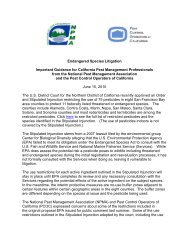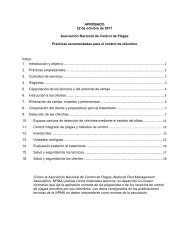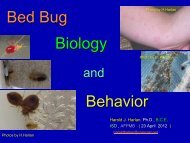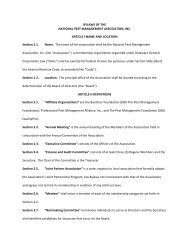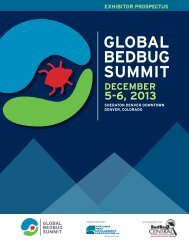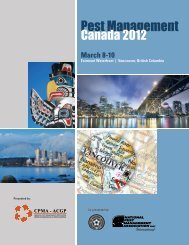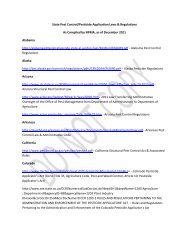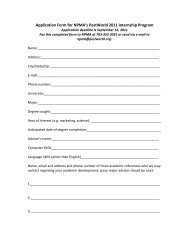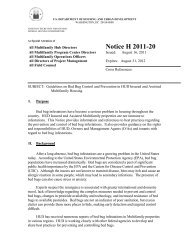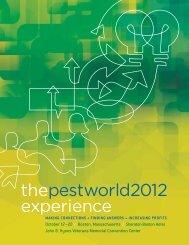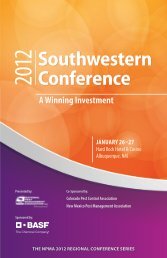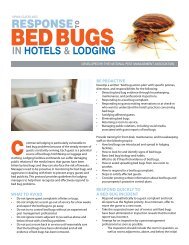Pest Management Standards For Food Plants - National Pest ...
Pest Management Standards For Food Plants - National Pest ...
Pest Management Standards For Food Plants - National Pest ...
Create successful ePaper yourself
Turn your PDF publications into a flip-book with our unique Google optimized e-Paper software.
SECTION 2: PEST MANAGEMENT PLAN<br />
2.6 Rodent Program-Monitoring<br />
2<br />
SECTION<br />
Adjustments to the program based upon observations may be made at any time. Use of<br />
“temporary” program changes are acceptable. All traps, bait stations, and other devices<br />
must be opened and inspected. Record of service verification or bar code shall be on the<br />
inside of the station requiring the station to be opened. Observations must be recorded as<br />
outlined in the Recordkeeping section.<br />
A master map of all rodent control devices used on the property must be maintained and<br />
kept current.<br />
Rodents must be disposed of in a sanitary method offsite per company policy. Rodents,<br />
droppings, and any urine deposits or residue must be handled using protective gear per<br />
company policy.<br />
2.7 Insect Program<br />
Inspection<br />
A thorough inspection shall be conducted of the exterior of the building including<br />
raw material receiving, receiving docks, shipping docks, load levelers, waste disposal,<br />
entrances, roof areas, exterior storage such as silos, doors and windows, and ventilation<br />
intakes to investigate signs of infestation or possible signs of infestation by stored product<br />
insects.<br />
A thorough inspection of the accessible components of the plant shall be conducted<br />
not less than monthly. The areas to be inspected includes but is not limited to floor/wall<br />
junctures, drop ceilings, equipment, processing areas, warehousing materials and racking,<br />
offices, locker rooms, mezzanines, raw material handling and processing, returned goods<br />
areas, sample areas, windows, ventilation, shop areas, packaging storage and equipment,<br />
laboratory areas, and cafeteria. See 2.10 for documentation.<br />
In the course of the inspection, maintenance issues such as but not limited to holes<br />
in walls, pipe chases, bulk feed lines, spilled food items, or open doors/windows shall<br />
be noted. Recommendations shall be made to the plant to reduce chances of future<br />
infestation.<br />
Stored Product Insects<br />
Determination of the source of stored product pests must be completed prior to action.<br />
Sometimes, a certain lot of raw materials can be isolated as the source. If pests have<br />
spread into the plant, management measures must be performed.<br />
Pheromones and pheromone traps may be used as part of the monitoring and<br />
management processes.<br />
Non-Stored Product Insects and Occasional Invaders<br />
Determination of source and entry point, real or potential, is necessary in developing a<br />
control/management program. Commonly, mechanical alterations on the exterior will<br />
be necessary such as filtering incoming air, sealing cracks, repairing door gaskets or self<br />
closing doors, etc.<br />
Prevention and <strong>Management</strong> of Insects<br />
Insects shall be managed using a product labeled for the site. These products may be<br />
residual or non-residual products.<br />
12



